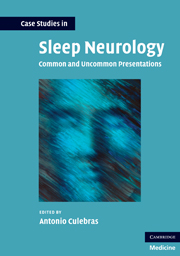Book contents
- Case Studies in Sleep Neurology
- Case Studies in Sleep Neurology
- Copyright page
- Dedication
- Contents
- ContentsThe following cases described herein have been published previously
- Foreword
- Contributors
- Abbreviations
- Introduction
- Part I Sleep-related breathing disorders
- Part II Hypersomnias of central origin
- Part III Circadian rhythm disorders
- Part IV Parasomnias
- Part V Sleep-related epilepsy
- Part VI Sleep and stroke
- Part VII Sleep-related movement disorders
- Case 32 Violent tongue biting recurring during sleep
- Case 33 A child with behavioral problems and violent sleep behavior leading to trauma
- Case 34 Clicking all night
- Case 35 Repetitive arm movements
- Case 36 Restlessness and jerking upon recumbency when trying to fall asleep
- Case 37 Jumping and yelling while asleep
- Case 38 A case of attention deficit
- Part VIII Neuromuscular disorders and sleep
- Appendix: Epworth Sleepiness Scale
- Index
Case 36 - Restlessness and jerking upon recumbency when trying to fall asleep
from Part VII - Sleep-related movement disorders
Published online by Cambridge University Press: 10 November 2010
- Case Studies in Sleep Neurology
- Case Studies in Sleep Neurology
- Copyright page
- Dedication
- Contents
- ContentsThe following cases described herein have been published previously
- Foreword
- Contributors
- Abbreviations
- Introduction
- Part I Sleep-related breathing disorders
- Part II Hypersomnias of central origin
- Part III Circadian rhythm disorders
- Part IV Parasomnias
- Part V Sleep-related epilepsy
- Part VI Sleep and stroke
- Part VII Sleep-related movement disorders
- Case 32 Violent tongue biting recurring during sleep
- Case 33 A child with behavioral problems and violent sleep behavior leading to trauma
- Case 34 Clicking all night
- Case 35 Repetitive arm movements
- Case 36 Restlessness and jerking upon recumbency when trying to fall asleep
- Case 37 Jumping and yelling while asleep
- Case 38 A case of attention deficit
- Part VIII Neuromuscular disorders and sleep
- Appendix: Epworth Sleepiness Scale
- Index
Summary
Keywords
- Type
- Chapter
- Information
- Case Studies in Sleep NeurologyCommon and Uncommon Presentations, pp. 255 - 261Publisher: Cambridge University PressPrint publication year: 2010

